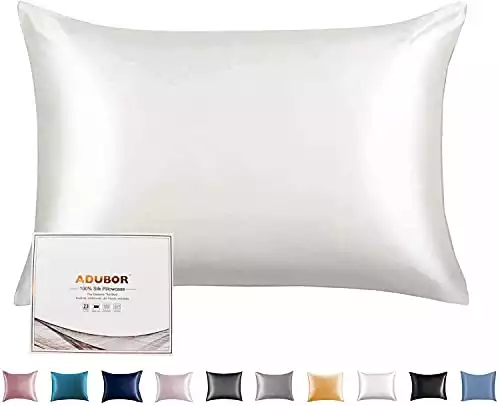Jump to:
You bleached your hair, and now it feels rubbery and tangles easily. It looks terrible, and you’ve been told you have “gummy hair.” So, how to fix gummy hair?
Depending on your preference and options at your disposal, there are a number of steps you can take to get your hair from severely damaged to healthy again.
How to Fix Gummy Hair 8 Different Ways

Voyagerix/Shutterstock
There are a few steps to take to fix gummy hair. Over-processed hair is damaged permanently. The only real solution is to let it grow out. Until then, there are everyday things you can do to make your hair shiny and manageable again:
- Go to a Salon
- Cut Your Hair
- Give Your Hair a Break
- Use a Shampoo with Protein
- Moisturize, Moisturize, Moisturize
- Use Hair-Friendly Oils
- Think about Supplements
- Switch Your Pillowcase
Keep reading to learn more about the best ways to fix gummy hair.
1. Go to a Salon
Gummy hair is often the result of too much styling or harsh chemical processes. Bleaching is usually the culprit, but you can also get gummy hair from perming or chemical straightening.
While accidents can happen in a salon, over-processing most commonly occurs when we attempt to bleach our hair at home. If this happens to you, call your local salon. They’ll set you up with a professional who will know best how to fix gummy hair.
They’ll do damage control. This will probably include a protein-rich conditioning treatment and a trim. You’ll get the best advice from your hair specialist on how to manage your damaged hair. This will most likely include commended products and scheduling your next salon appointment.
2. Cut Your Hair
Accept that you’ve done permanent damage to your hair. You can make it less gummy, but your hair isn’t going to be the same. It’s much easier to deal with when it’s shorter. Ask your stylist how much length they recommend cutting off to fix gummy hair.
You could start over completely by cutting off all the gummy hair. If you don’t want to go that short, you’ll have to get regular trims every 6- to 8-weeks. Trims will prevent hair breakage, which can cause even more damage. They’ll also give your hair a chance to grow out and return to a healthy state!
3. Give Your Hair a Break
Day to day, you put your hair through a lot of wear and tear. You probably brush your hair, expose it to sunlight, and wash it every few days. Usually, you don’t have to think much about how your daily routine damages your hair.
But when you’ve over-processed your hair, you have to take extra care. To fix gummy hair, you should take a break from certain things. Give your hair a chance to recover by doing the following:
- Limit hair washing to 1- or 2-times a week with lukewarm water.
- Don’t use heat on your hair.
- Don’t use elastic bands on your hair.
- Just say no to more chemical processes, like coloring or perms.
All of these things can stress your hair, leading to more damage and ultimately breakage. Shampooing can dry out your hair even more. Showering with hot water that pulls oils from the hair shaft. Also, if you comb wet hair, it will break more easily than dry hair.
Minimize washing your hair and let it benefit from the natural oils in your scalp. If you want to save your hair, you’ll have to find ways to live without curling irons and blow dryers. Applying heat dries out already brittle hair. Elastic bands weaken hair even more than it already is, leading to breakage.
Finally, While you may be tempted to color your damaged hair, leave that decision up to the professionals. Applying even more strong chemicals to your hair won’t make your hair look any better. It’ll probably just undo any repairs you’ve already done!
4. Use Shampoo With Protein
Your hair is made of layers, with the deepest and more important layer being made of a protein called keratin. This protein gives your hair strength, durability, and elasticity. It stays healthy by retaining moisture.
The outer layers of your hair keep in the moisture. Gummy hair has been damaged to the core, drying it out and making it brittle.
One of the first things you can do to fix gummy hair is to use the right shampoo. Look for a keratin-rich, sulfate-free shampoo to use while your hair is healing.
5. Moisturize, Moisturize, Moisturize
Gummy hair is the result of damaging the outer layers of hair. These layers work to keep moisture locked inside the protein-rich center. One of the best things you can do to fix gummy hair is to add moisture back in.
You can do this by conditioning hair after every shampoo. Conditioners are a great tool to fix gummy hair. They help to heal the outer layers of your hair, helping it naturally retain more moisture. They also minimize frizz and make it easier to comb through hair so there’s less breakage.
Look for conditioners with ingredients like argan oil. Leave-in conditioners are also a great option for dry, damaged hair. Everyday hair conditioners seal in moisture after you wash it. Deep conditioning hair masks do even more by working to restore hydration through all the layers of the hair follicle.
They’re a lot thicker and creamier than conditioners and tend to have ingredients like avocado oil or shea butter. Use a hair mask once a week, and be consistent to see results.
You can also make homemade conditioning masks using protein- and moisture-rich natural ingredients. Think of things like eggs or avocado. Use some of these combinations:
- 1/2 avocado and 1/2 cup olive oil
- 1 part jojoba oil and 1 part coconut oil
- 1 part almond oil and 2 parts honey
- 2 eggs and 1/3 cup olive oil
Just remember to rinse with cool water if you’re using ingredients like eggs, so they don’t cook in your hair. Keep the mask on for an hour under a shower cap, and then wash your hair like normal. Then you could also rinse hair with rice water as a natural protein-rich conditioner.
6. Use Hair-Friendly Oils
Oils are important in reducing hygral fatigue. This is when wet hair swells and then dries and shrinks. This process leads to damage to the follicle. When working to fix gummy hair, it can benefit from vitamins and lipids in different oils.
Consider one of the following:
- Coconut oil
- Castor oil
- Argan oil
- Jojoba oil
- Sesame oil
- Olive oil
- Almond oil
Use an overnight oil mask in a 2-fold approach to both moisturize hair and encourage growth. Start by applying oil from roots to tips. Stimulate hair growth by massaging the scalp in circular motions with your fingertips.
Wrap your hair in a towel, and soak overnight. Rinse in the morning, washing and conditioning as usual. You can add oils to your routine 1-2 times a week.
7. Think About Supplements
Talk to your doctor about supplements you could take to encourage hair growth and health. Supplements like biotin, collagen, omega 3 fish oil, and vitamin E have different benefits for your hair.
Your doctor can point you to quality brands they trust for OTC supplements. You can also ask them about dietary changes that might help. Perhaps you need more protein or healthy fats in your diet. Even improving your water intake can have great benefits for your hair and skin!
8. Switch Your Pillowcase
You’re spending 6-9 hours a night with your head against a pillow. Tossing and turning can cause damage to already damaged hair. Consider investing in a silk pillowcase. They cause less friction than a more common cotton pillowcase.
Cotton also absorbs moisturizing oil from your hair more than silk does. When looking for a quality silk pillow, look for mulberry silk, made from silkworms in Asia that feed on mulberry trees. Also, look for a high thread count (aim for 25mm) and silk letter grade.
True mulberry silk pillowcases will have all of this information available to you at a glance. Buy mulberry silk and know that your pillowcase will last you for years to come. If you have convictions about using a silk pillowcase from silkworms, you could always go with 100% polyester satin.
It’s smooth like silk, it’s vegan, and it’s easier on your wallet. However, it doesn’t last as long as mulberry silk. Also, watch out for cotton and satin blends.
Frequently Asked Questions
When you’re dealing with gummy hair, some questions may come to mind. Keep reading for the most commonly asked questions concerning how to fix gummy hair:
What does “gummy hair” mean?
Your hair is made up of layers of proteins. Protein makes hair elastic, but when it becomes gummy, that means it’s too stretchy. Applying bleach opens the layers of the hair to remove melanin, or color, from your hair.
If you don’t apply bleach properly, those layers can’t close back up to protect your hair. This is when you get over-processed or gummy hair.
What does gummy hair feel like?
It feels sticky or rubbery. You can’t run your hand through your hair because it’s so tangled, and when you do, it breaks. The hair snaps like a rubber band because it’s too stretchy from being damaged. Gummy hair is also dull with no shine or dimension.
Can you dye gummy hair?
Your hair is in no condition to be color-treated. Adding more chemical processing to your hair at this point can just add to the damage. Plus, it won’t look that great. Give your hair some tender loving care and give it a break from coloring for the time being.
How do I fix gummy hair fast?
There’s no quick fix for over-processed hair, but you can make it less gummy with a good conditioning treatment. You can’t fully fix over-processed hair, but you can create a routine to make it manageable. This will also keep it from becoming even more damaged. Include things like regular treatments and trims.
Do you have to cut off gummy hair?
You should at least get a trim when fixing gummy hair. Even after treatment, over-processed hair can be frizzy and hard to manage. It’ll break off easily. The best thing to do is to cut off most of the gummy hair and start over. If you don’t want to do this, get regular trims as it grows out.
So, How Do You Fix Gummy Hair?
To fix gummy hair, your first step should be to visit the salon. After that, focus on rebuilding your hair’s integrity with protein and moisture. Minimize future damage by taking steps to care for your over-processed hair.
Finally, create a consistent routine and introduce products that will give you the best chance for a healthy, shiny, strong mane!

